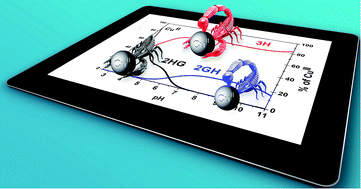Branched peptide with three histidines for the promotion of CuII binding in a wide pH range – complementary potentiometric, spectroscopic and electrochemical studies†
Abstract
Modifications in linear and cyclic peptides have been widely explored in relation with the associated effects on the coordination of CuII. Branching of peptides is yet another innovative conception to promote metal binding. The three dimensional (3D), quasi-tripodal structure of the new ligand, H-His-Dap(H-His)-His-NH2 (3H, where Dap = L-2,3-diaminopropionic acid), which is created by the vicinal two N-terminal and one C-terminal functions of Dap allows triple-arm extension and offers new options in metal binding. A strategy is presented for the characterization of 3H focusing on the role of structural domains in CuII binding by comparison of analogous tetrapeptides that involve a varying number of His and Gly residues. Potentiometric, spectroscopic (UV-Vis, CD and EPR), mass spectrometric and electrochemical data indicate that in monomeric CuII–3H complexes the metal is bound with higher affinity compared to its structural domains indicating that the effect of 3D branching should be taken as an important factor for future studies on CuII peptide constructs.


 Please wait while we load your content...
Please wait while we load your content...